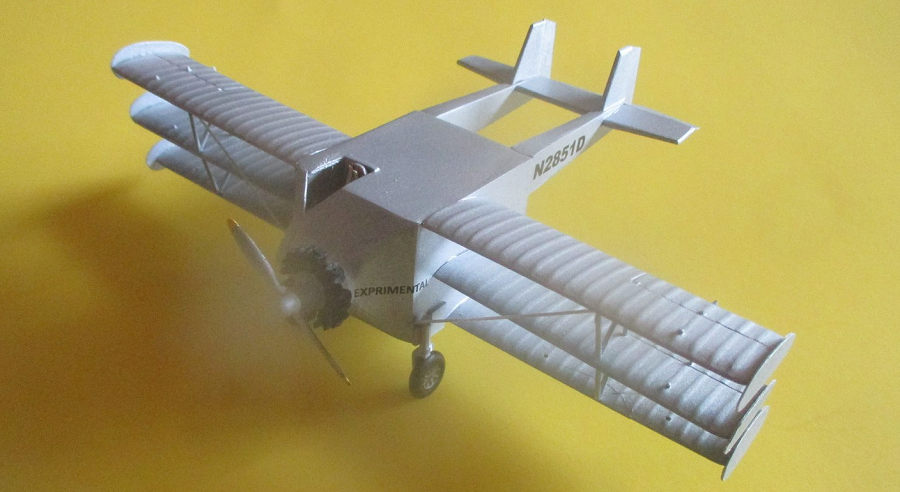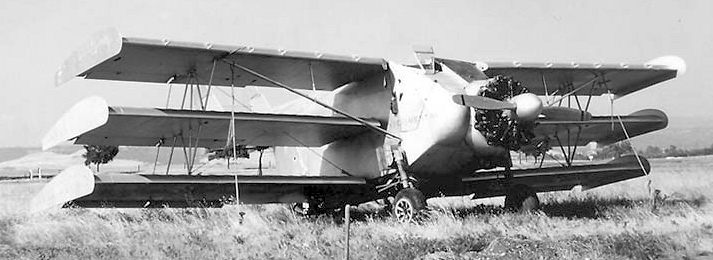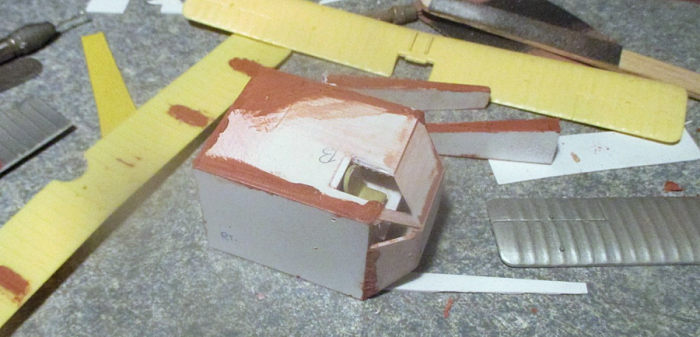
1/72 DeKellis 'Air Truck'
| KIT #: | |
| PRICE: | |
| DECALS: | Home MadeNo options |
| REVIEWER: | Brian Baker |
| NOTES: | Scratchbuilt and spares. |

| HISTORY |
I received photos of this airplane a while back from noted aviation photographers William T. Larkins and Col. Boardman C. Reed, (USAF Ret.), and couldn’t resist building a model of it.
Both of these men were my mentors in aviation photography, and Bill Larkins was the originator of the American Aviation Historical Society. Both men are accomplished authors of aviation subjects.
 The problem
was that I only had sharp angle three quarter front views of the aircraft, and
although I got the dimensions from the aerofiles.com website, I had to make some
estimates as to the size and shape of the rear portion of the plane.
The problem
was that I only had sharp angle three quarter front views of the aircraft, and
although I got the dimensions from the aerofiles.com website, I had to make some
estimates as to the size and shape of the rear portion of the plane.
The plane was designed by Tom DeKellis in Oroville, CA, back in the fifties. DeKellis operated a crop dusting company and had a couple of 450 hp. Stearmans. He wanted something more efficient, and thought that a triplane would do the trick, as it would be better for low and slow dusting and spraying operations. He built the plane with local materials, and used a war surplus 450 hp. Pratt and Whitney R-985 radial engine. A boxy fuselage structure housed the spray tank or dust hopper, and according to a contemporary newspaper article, it would also house a jeep. I am not sure of the type of dusting or spraying installation mounted on the airplane, as this doesn’t show in the photos, and the plane probably never progressed beyond a few test flights anyway, as the last photo I have had substantial structural damage to the tail section. I doubt that the airplane flew very well, and it probably never had agricultural dispensing equipment installed.
| CONSTRUCTION |
 The model
is basically scratch built. I had in the past built a couple of rotary winged
Airfix Avro 504 models, as a few of these were experimented with in the
twenties, so I had the wings in my scrap box. These were ideal, and were the
correct size. The fuselage was built up from card plastic, with the nose section
built up from plastic putty. The engine is from the spares box, and the prop is
from a Hawk AT-6.
The model
is basically scratch built. I had in the past built a couple of rotary winged
Airfix Avro 504 models, as a few of these were experimented with in the
twenties, so I had the wings in my scrap box. These were ideal, and were the
correct size. The fuselage was built up from card plastic, with the nose section
built up from plastic putty. The engine is from the spares box, and the prop is
from a Hawk AT-6.
The tail section consists
of two tapered booms, which I made from plastic card, using strips for internal
bracing. My photos show a structure made of steel tubing with probably fabric
cover, but card plastic worked very well. The landing gear was made from parts
in my spares box, as was the engine and propeller.
 It is tough
working with limited information, but neither of my sources was available for
consultation. I used the photos for reference, and I’ve never heard of anyone
insane enough to have built a model of this airplane before.
It is tough
working with limited information, but neither of my sources was available for
consultation. I used the photos for reference, and I’ve never heard of anyone
insane enough to have built a model of this airplane before.
Anyway, it was a fun project, and took me about a week to complete. Fortunately, I have a color photo of the plane, and it is silver overall, with no trim except for the printed “Experimental” on the forward section of the fuselage, as required by CAA/FAA regulations, and the “N” number, N2851D, which was painted on the rear fuselage boom sides. The plane, incidentally, was taken off the civil register a few years later, and now the number is carried by another aircraft. It must have flown at least once, as one photo I have of it shows some damage to the tail unit.
| CONCLUSIONS |
So the result is a model like no other, although it fits in well with the dozen or so models of crop dusters and sprayers that I have built over the years. It is digging up information on these unusual aircraft types that makes modeling fun, building a model of something nobody has ever heard of before.
Brian Baker
28 September 2021 Copyright ModelingMadness.com. All rights reserved. No
reproduction in part or in whole without express permission. If you would like your product reviewed fairly and fairly quickly, please contact the editor
or see other details in the
Note to
Contributors.